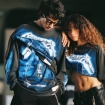Ambitious, uncompromising and heavy as all hell, 1988's …And Justice for All found Metallica pushing their original thrash-metal vision to its limits. Even for diehard fans, it was a lot to digest at first: Not one of the double album's nine songs clocked in at under five minutes, while "To Live Is to Die" and the epic title track stretched out to nearly twice that length. And, of course, there was the strange matter of Jason Newsted's undermixed bass, a factor which only added an extra degree of harshness to the proceedings.
Indeed, nothing about …And Justice for All was remotely "commercial" in the conventional sense; even "One," the band's first Top 40 hit, was a harrowing seven-and-a-half-minute tale of a soldier who somehow lived on despite having his arms, legs, and face blown off. And yet, the demand for new Metallica music was so strong by the summer of 1988 that the band's fourth album reached Platinum status — one million albums sold — just nine weeks after its August 25th release. (The album has since gone on to sell over seven million more copies in the U.S. alone.) If 1986's Master of Puppets marked the point where the non-metal world first became aware of Metallica, …And Justice for All was proof that extreme metal could connect with a broader fan base.

It was clear to the band even before they began recording that their first real follow-up to Master of Puppets —and their first album of original material with new bassist Newsted — would have to be a major statement, and that some heavy-duty cover art would be needed to reinforce it. To that end, the band's management reached out to Roger Gorman, founder of Reiner Design Consultants, who had previously done album covers for Billy Squier, Dokken and Tony MacAlpine — as well as The $5.98 E.P.: Garage Days Re-Revisited, Metallica's all-covers stop-gap from the previous year.
"Lars [Ulrich] was the point man with the band," Gorman recalled in the 2015 book, …And Justice for Art. "He was happy with the EP design, and we got along great. So, when the …And Justice for All's project came along, it was like: 'Hey guys, do you want to get involved with this? Ok, make it work!'… It was a great opportunity."
The band already had the album title, and Ulrich communicated to Gorman that he had a very specific cover image in mind to go with it: a statue of blind justice being pulled from its plinth, scales and all. "The conversation focused on how we take that concept and make it visually arresting," Gorman explained to Unbuilt magazine in 2016. "This was still the time of the full-size vinyl albums so it needed to be detailed and visually rich but, at the same time, the art would be adaptable to the CD, CD long box and cassette packaging proportions."
After a lengthy debate about whether to render the image as a painting or a photograph, it was decided that a "photo-realist" style of painting would render the greatest impact, while also giving Gorman and the band greater latitude in terms of fine-tuning the artwork. Gorman asked his brother Stephen, who'd also done the design for the band's infamous "Metal Up Your Ass" T-shirt, to create an acrylic painting for the cover.
Stephen, who was working as an illustrator in Munich, Germany, at the time, already knew of the perfect "model" for the cover. "The statue reference was based on the Lady Justice statue that stood atop of the High Court in Frankfurt," Stephen Gorman told Unbuilt. "It was the most feminine and sexy version that we could find of the statue."
Stephen further amplified the statue's curves — even exposing one breast for, er, titillating effect — before doing some additional local research in order to accurately depict the crumbling of the album's statue. "I was working in Munich and there's a great museum in the center of the city called the Glyptothek which is crammed full of disintegrating Roman statues," he told Unbuilt. "These were my main inspiration for the fragmentation process for the painting."
The band then provided further input, asking Stephen to emphasize the dollar bills on the statue's scale, and to make the statue's body more metallic-looking. Slight adjustments to the image would have to be made according to format — the CD long box was the only medium long and narrow enough to display the complete painting — but Lars and Co. pronounced themselves pleased with it.
"The band seemed to be very happy with the work and I thought that was that," Stephen told Unbuilt. "To my surprise, however, I received a call from management a couple of months later. The band was doing a six-date tour of Germany and would love for me to come along for the ride. I had heard that they had a stage version of the cover made and I was dying to see that in action."
On November 3rd, 1988, he got his wish. The band's management hired a limo to ferry Stephen from Munich to the Donauhalle in Regensburg, where he was treated to a live blast of …And Justice for All material. "I was really enjoying being in the audience with all these crazy German heavy-metal fans when James Hetfield announced, 'Stephen is going to love this fuckin' bit!'" he recalled. "At this point, the 20-foot-high statue was pulled to the ground amidst a barrage of pyrotechnics and the crowd went wild! It was quite an experience, of course."








